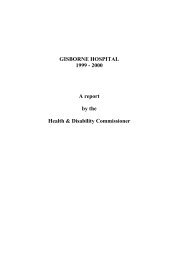09HDC01565 - Health and Disability Commissioner
09HDC01565 - Health and Disability Commissioner
09HDC01565 - Health and Disability Commissioner
Create successful ePaper yourself
Turn your PDF publications into a flip-book with our unique Google optimized e-Paper software.
<strong>Health</strong> <strong>and</strong> <strong>Disability</strong> <strong>Commissioner</strong><br />
184. Ms Pirret, the nursing expert consulted by the legal representative for RN Ms I <strong>and</strong><br />
RN Ms K, comments on this, noting that it ―risks sending messages to nursing staff<br />
that the respiration rate is of less importance when compared to other neurological<br />
observations‖. I agree. Ms Pirret further states that while respiration is an important<br />
vital sign, it has historically been poorly documented by nurses. My nursing expert,<br />
Ms Hewson, similarly notes that it has been found to be ―the most neglected vital<br />
sign‖. All the more reason, in my view, for CDHB to ensure its forms are designed to<br />
encourage, not discourage, the recording of respirations.<br />
185. I note that the chart has since been redesigned to incorporate the Early Warning Score<br />
system, which includes respiratory rate, for the early identification of patients who are<br />
at risk or who are deteriorating.<br />
“Specialling”<br />
186. CDHB states that it had become established practice for the ―specialling‖, or the close<br />
observation of SCU patients, to cease at the end of the first postoperative night (6am)<br />
or at the time of the morning nursing h<strong>and</strong>over (6.45am), 36 rather than at the time of<br />
the morning medical review, which was usually at about 9am. This practice evolved<br />
in relation to patients who had experienced an uneventful first postoperative night. I<br />
consider that this practice was not acceptable. I note also that under this arrangement,<br />
a patient who had undergone surgery during the night would also have ceased to be<br />
―specialled‖ at 6am, regardless of how long that patient had been in the SCU.<br />
187. CDHB has now changed this practice, <strong>and</strong> patients continue to be ―specialled‖ until<br />
they have been medically reviewed.<br />
Postoperative monitoring regime<br />
188. There is also the issue of the adherence by nursing staff to the postoperative<br />
monitoring regime documented by Dr F. Dr F‘s instruction was for neurological<br />
observations to be checked every 15 minutes for one hour, every 30 minutes for two<br />
hours, <strong>and</strong> then hourly. He did not specify when the hourly monitoring should end,<br />
but subsequently told HDC that if there were no concerns warranting an early review,<br />
―in general‖, postoperative instructions are effective until medical review the next<br />
morning. However, Dr F also acknowledged that the nursing staff moved to twohourly<br />
monitoring overnight in accordance with the SCU protocol.<br />
189. This protocol, contained in the ―SCU Clinical Information & Nursing Management<br />
Guidelines‖, sets out the regime for postoperative neurological observations following<br />
posterior fossa surgery: half-hourly observations for four hours, hourly observations<br />
for four hours, <strong>and</strong> then two-hourly observations for four hours or overnight until<br />
changed by medical staff. I have some concern that the wording of the instruction in<br />
this policy is potentially ambiguous in relation to the need for medical review. CDHB<br />
states that it was ―usual practice‖ in the unit to change to two-hourly monitoring<br />
overnight if there were no concerns.<br />
36 The RCA report refers to 6am, while other correspondence to HDC refers to the time of nursing<br />
h<strong>and</strong>over, ie, 6.45am.<br />
5 September 2012 32<br />
Names have been removed (except Canterbury DHB <strong>and</strong> the experts who advised on this case) to<br />
protect privacy. Identifying letters are assigned in alphabetical order <strong>and</strong> bear no relationship to the<br />
person’s actual name.
















